

Ended
Exhibition
Public production
Performance
Workshop
Other
K
Kanda・Yushima
JAPAN ART BRIDGE
mAAch ecute Kanda Manseibashi
25-4, Kandasudacho 1-chome, Chiyoda-ku, Tokyo
2023.9.23 - 11.5
11:00-18:00 Closed on 10.2
Ticket
Free
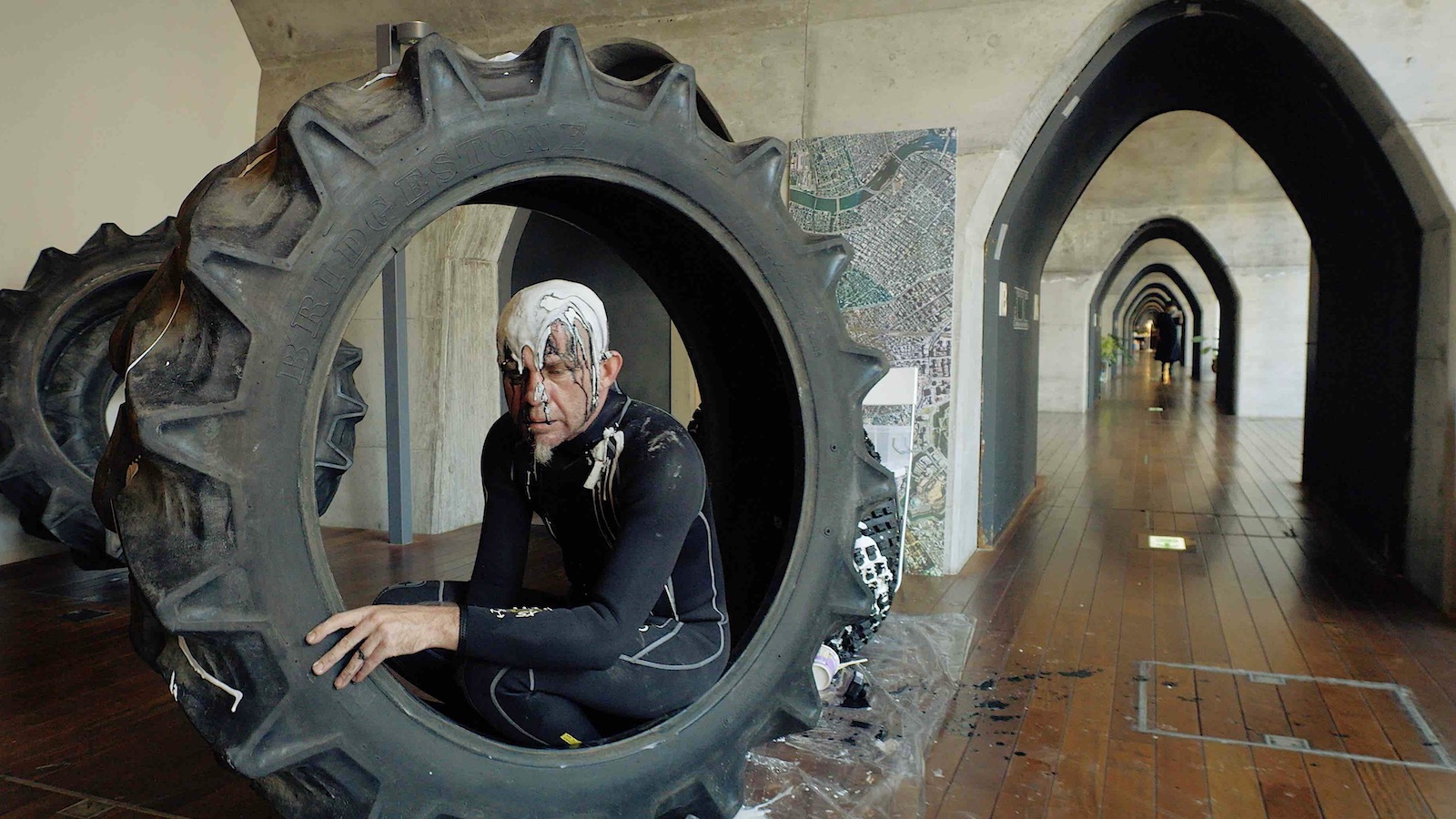
9.23 (Sat)–11.5 (Sun) *Closed on 10.2 (Mon). 11:00–18:00
JAPAN ART BRIDGE (mAAch ecute Kanda Manseibashi)(25-4, Kandasudacho 1-chome, Chiyoda-ku)
Free *Some programs charge a fee.
“Why is the River Laughing?” – takes a SOCIAL DIVE into Tokyo by diving into the river city. A 5-week program of socially engaged art, the project explores the significance of local rivers and canals, through river walks, street actions, workshops, performances, an exhibition, and a symposium.
The venue, Japan Art Bridge, is in a renovated historic viaduct at mAAch ecute on the Kanda River. The gallery has video art, mapping studies, and sculptural installation, and is an Open Studio for the creative team to develop the project as a site-responsive Artist in Residency process. It is also a venue for Events, and a Creative HQ for activities around the Sotobori outer moat system.
Supported by The Center for Philosophical Technologies at Arizona State University, and the School of Global Studies at Thammasat University.
SOCIAL DIVE: Artist-in-Residence Projects
For the SOCIAL DIVE Artist in Residence Projects, an open call program that was held in the previous Tokyo Biennale 2020/2021, twelve overseas artists were selected from over 1,535 applications. However, the projects of seven of those artists were postponed due to the effects of the coronavirus.For Tokyo Biennale 2023, we plan to invite the artists who were unable to come to Japan to present their works. The artists will “dive” into various areas of the Tokyo cityscape, observe the charm of people who live and gather there, and generate new values. While interacting with society, the artists will come to reveal various connections latent in the city. These connections may offer unexpected perspectives for those who live and work in Japan today, or viewpoints that are all too familiar for its inhabitants to notice.
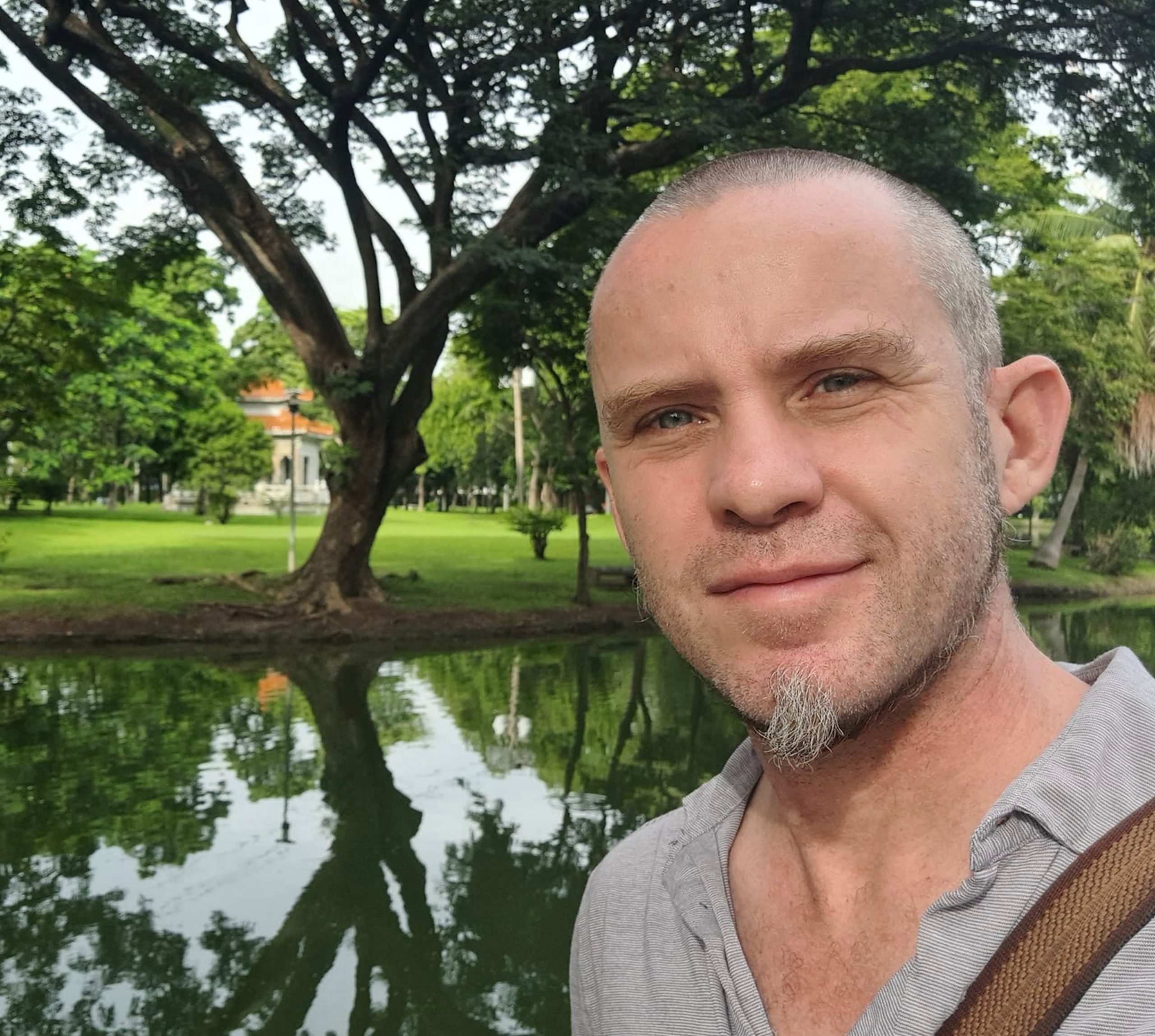
Michael Hornblow
Michael is an Artist / Researcher from New Zealand with a multidisciplinary background across dance, performance art, architecture and design, video, public art, and community development. He completed his PhD in the Spatial Information Architecture Laboratory at the Royal Melbourne Institute of Technology (Australia), and was a Postdoctoral Fellow in the Senselab at Concordia University in Montreal (Canada). Michael’s art presentations include Melbourne Festival, the International Symposium on Electronic Art (Sydney, Vancouver, Hong Kong); and a long history of creative work in Asia - training with Butoh masters in Japan, performing at Melaka Festival in Malaysia, Asiatopia International Performance Art Festival, and Bangkok Design Week in Thailand, Pelem and Arts Island Festivals in Indonesia. Michael is based in Bangkok, where he teaches in the School of Global Studies at Thammasat University. He is Co-Founder and Artistic Director of Buffalo Field Festival in the old town area of Nang Loeng, focused on site-specific performance and community engagement.
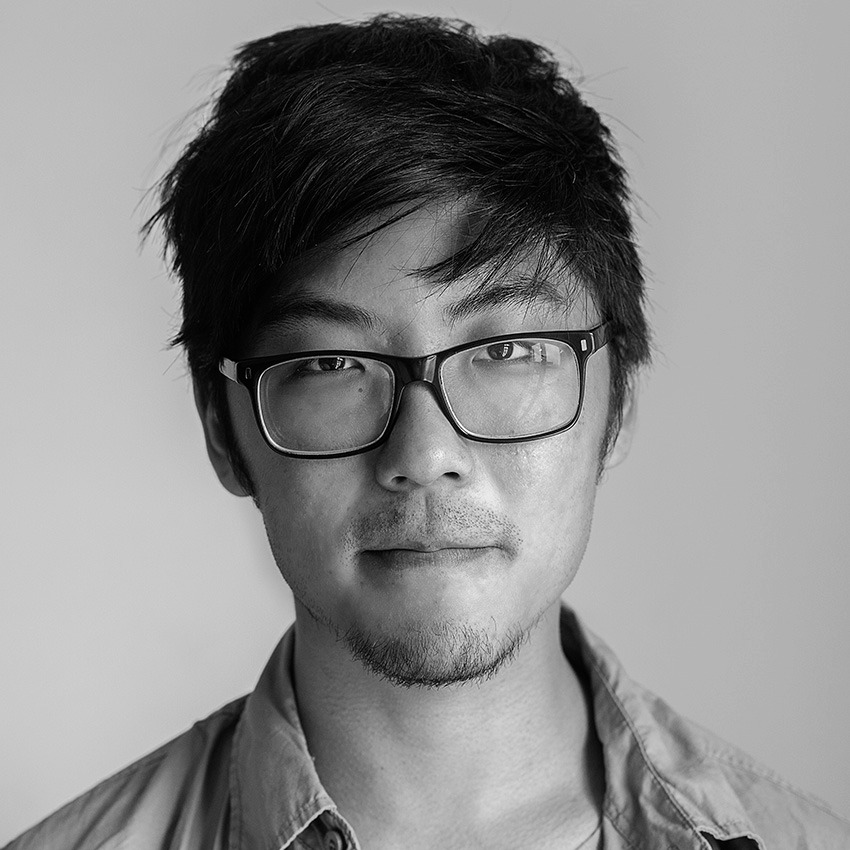
Yugo Hattori
Yugo Hattori is a Brazilian director and animator. His work uses a mix of video, animation and motion graphics, with a special interest in documentaries about social issues. His productions include "Minas do Futebol" (2017), and "Mundo Cabe em São Paulo" (2014). Yugo researches the process of democratization in filmmaking, guerrilla, low-budget cinema, and teaches film production pro bono for communities in the Global South, specially in Latin America and Southeast Asia.
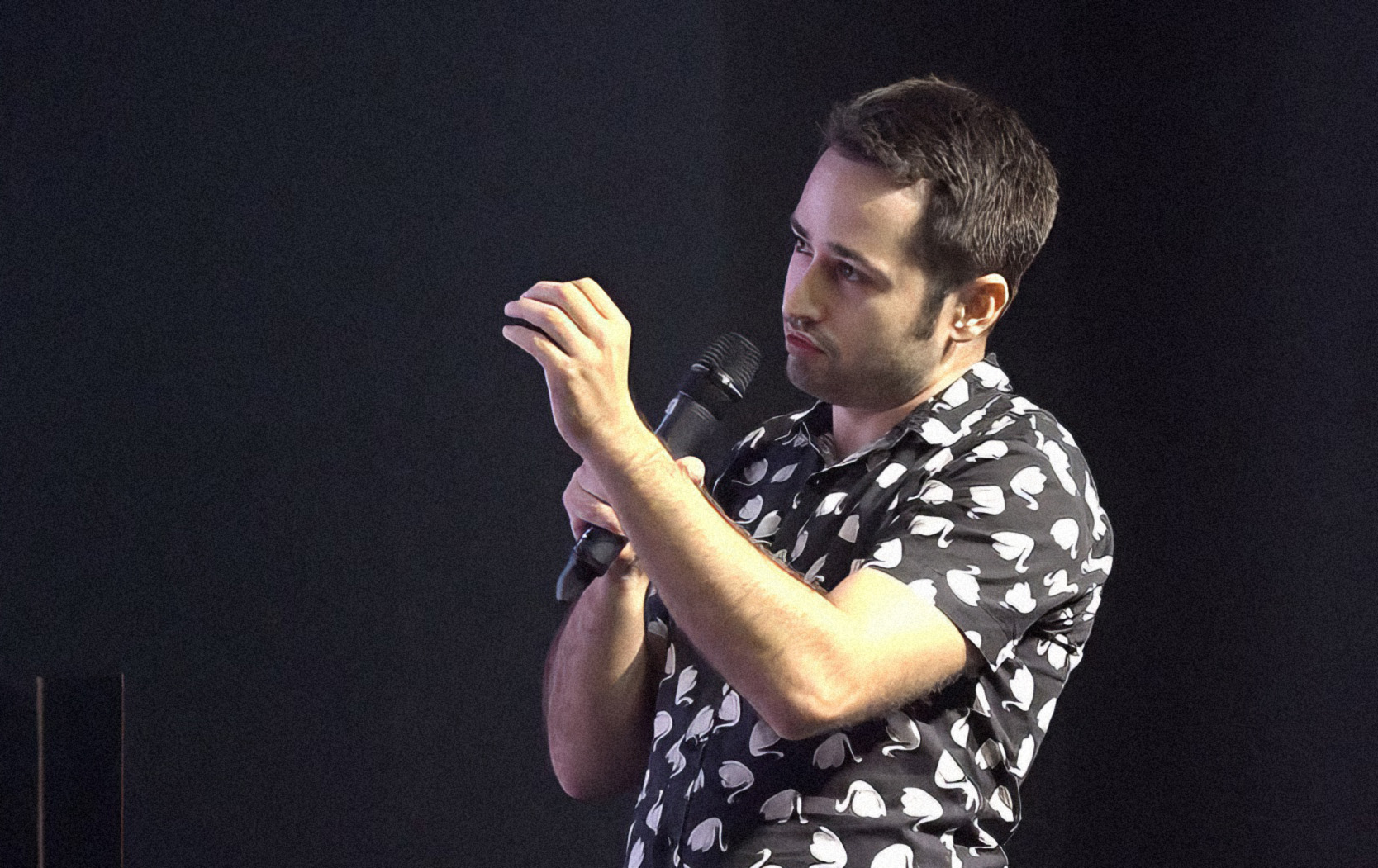
Gabriel Camelin
Gabriel Camelin is a French mix-media artist based in Bangkok, Thailand. Having majored in Film studies and Visual Communication, his work often relies on image manipulation, visual effects and collage in both video and still artworks. Gabriel is currently a full-time lecturer at Silpakorn University International College, teaching there since 2008. www.gabrielcamelin.com
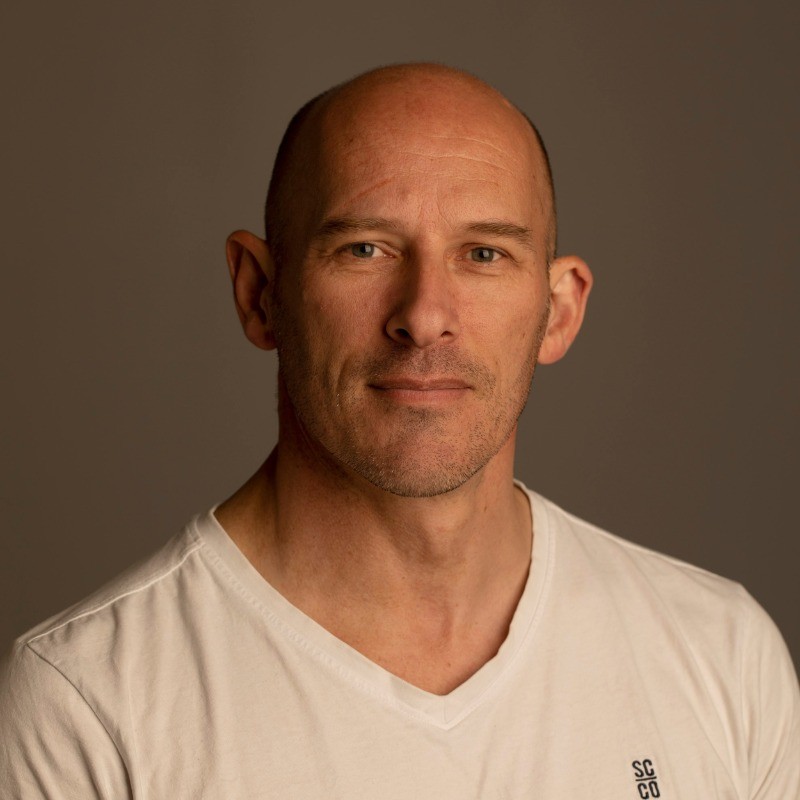
Tim Budgen
Tim Budgen is a digital motion designer and animator based in Christchurch, New Zealand. Tim has over 25 years experience in animation and post-production design for video installations, television, online media, and corporate events. He has also directed and produced music videos and creates motion graphics and visuals for live music events, festivals, and bands, including Shapeshifter, Salmonella Dub, Tiki Taane, Blindspott and Fly My Pretties. He has been an animation and motion graphics tutor for over 20 years, and currently works as Joint General Manager and content creator at Pixel Productions in Christchurch.
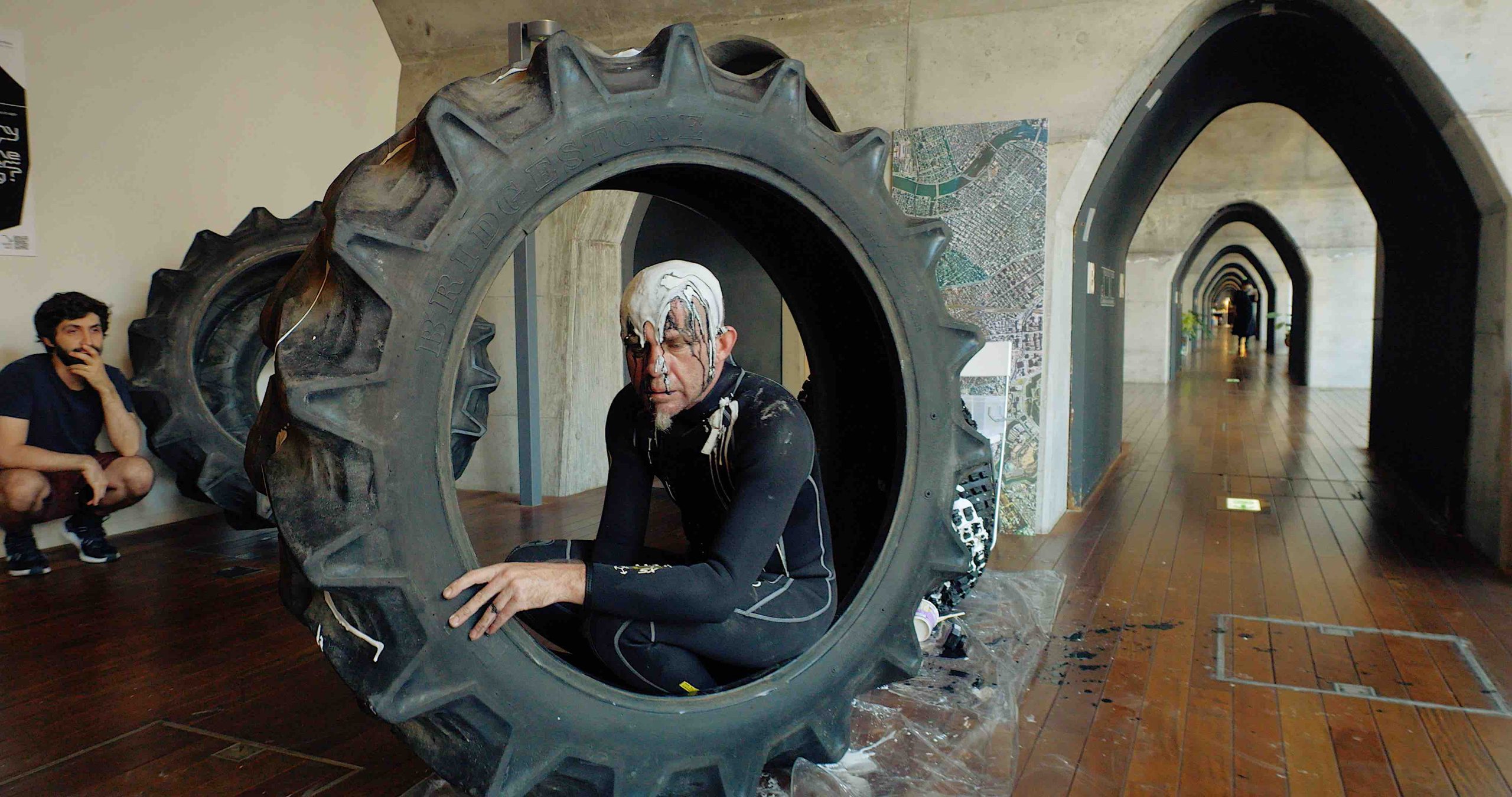
Performance, Sep.24. Image - Mitsuhiro Otta
This Soft Launch performance nudges us out into the stream of the residency process, with a 3-hour durational work… exploring the gallery spaces at mAAch ecute, feeling the pressure of time, and as a first contact with raw materials and concepts. Michael uses performance art and dance to connect to the building and the river, calling on hydro-mythical figures, from the Kappa to the Gargoyle, with old tractor tires as survey instruments, water walkers and wayfinders for charting strange terrains.
Date/Time: Sep.24 (Sun) 14:00–17:00
Venue: JAPAN ART BRIDGE, mAAch ecute Kanda Manseibashi
Admission: Free
*As a "durational" performance, you can enter and leave at any time.
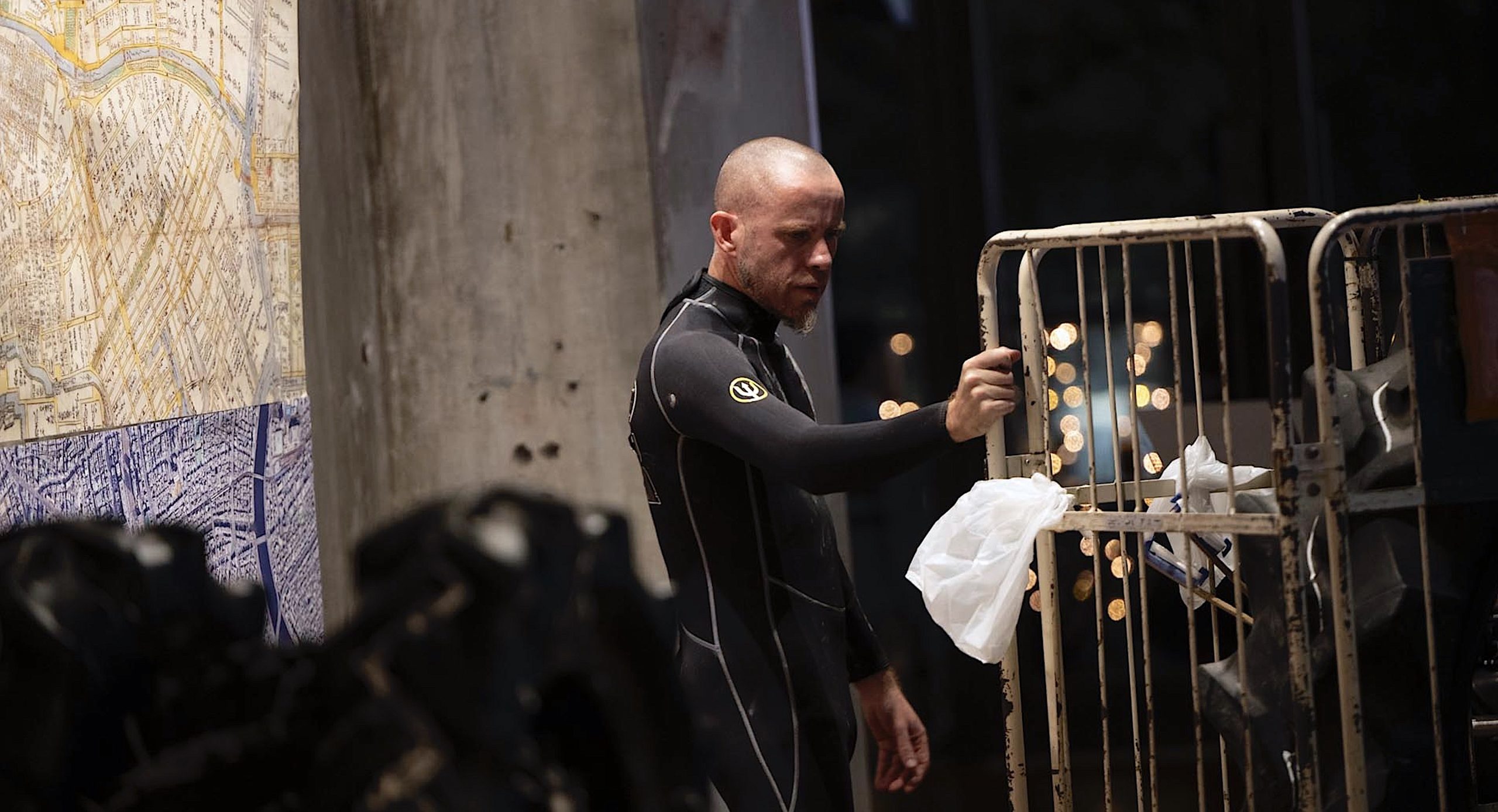
Performance, Sep.30. Image - Yugo Hattori
Post Futural Flows of Forever Now
Michael Hornblow and Matt Gingold present a collaboration in dance, performance art, sound and music, responding to the unique conditions of the old viaduct building at mAAch ecute, while exploring shared conceptual themes in their work, around time and history, nature and artifice, origin and extinction...
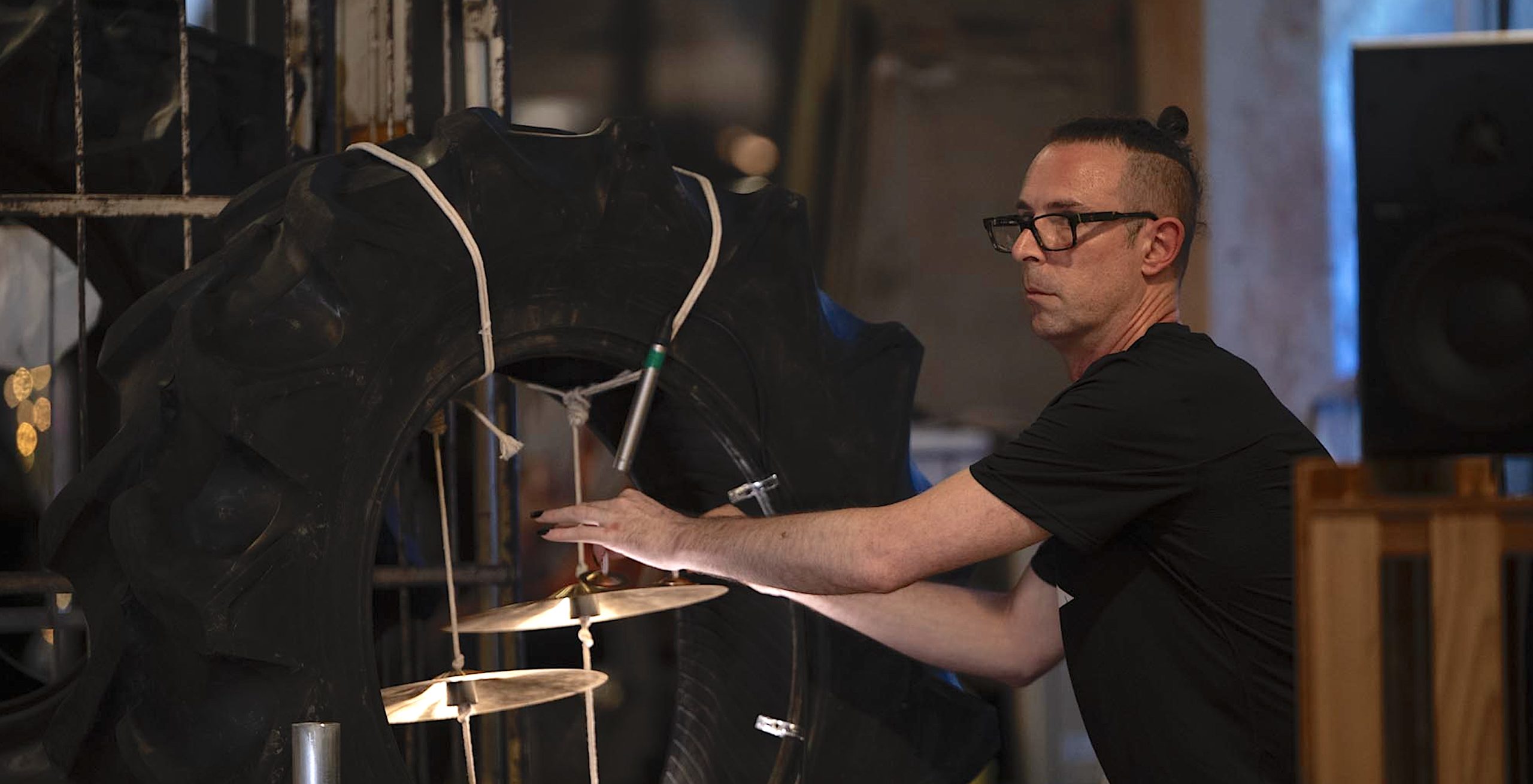
Performance, Sep.30. Image - Michael Porter
Michael uses performance art and dance to connect to the building and the river, calling on hydro-mythical figures, from the Kappa to the Gargoyle, with old tractor tires as survey instruments, water walkers and wayfinders for charting strange terrains. Matt joins as a special guest on the project, coming over from his own Artist Residency at the Asia Culture Center in South Korea, where he is developing The Absent Orkestra; a work about our experience of machines as emotional, political and magical entities.
Date/Time: Sep.30 (Sat) 18:30–19:30
Venue: JAPAN ART BRIDGE, mAAch ecute Kanda Manseibashi
Admission: Free, maximum 40 people
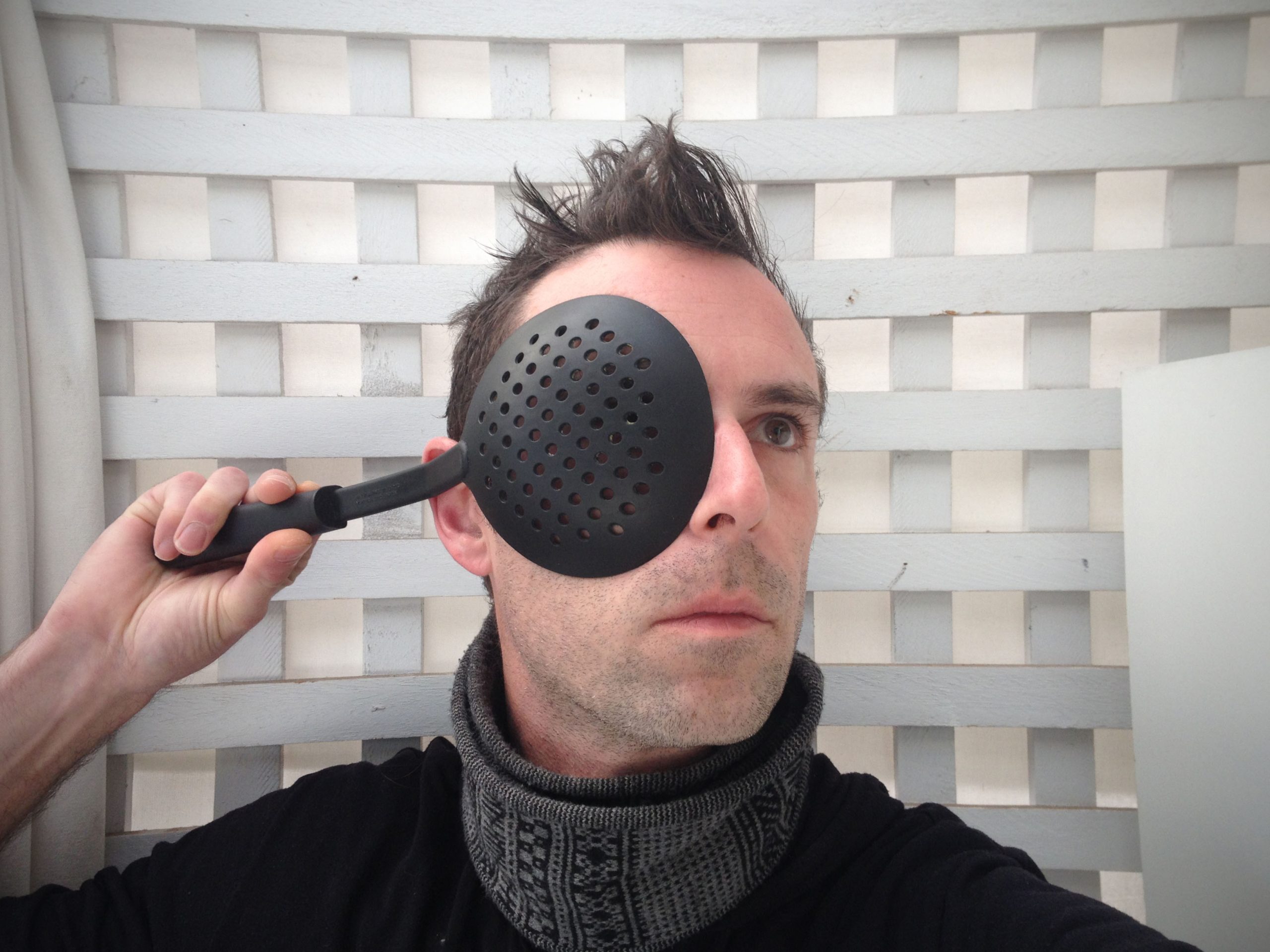
Matt Gingold is a transdisciplinary artist weaving together audio-visual installation, performance and critical theory. Inspired by research into the ai/aes/ethics of digital cultures and non/human complexity, their practice focuses on creating intimate experiences of – and with – technology. Often (con)fusing code, electronics and a large corpus of audio-visual media, they create mad and beautiful contraptions: cables and circuit boards are re-arranged care-fully in organic spatial and sonic forms, voicing the complexity of our emotional, political and magical relationships to the vibrant materiality of a/live machines.
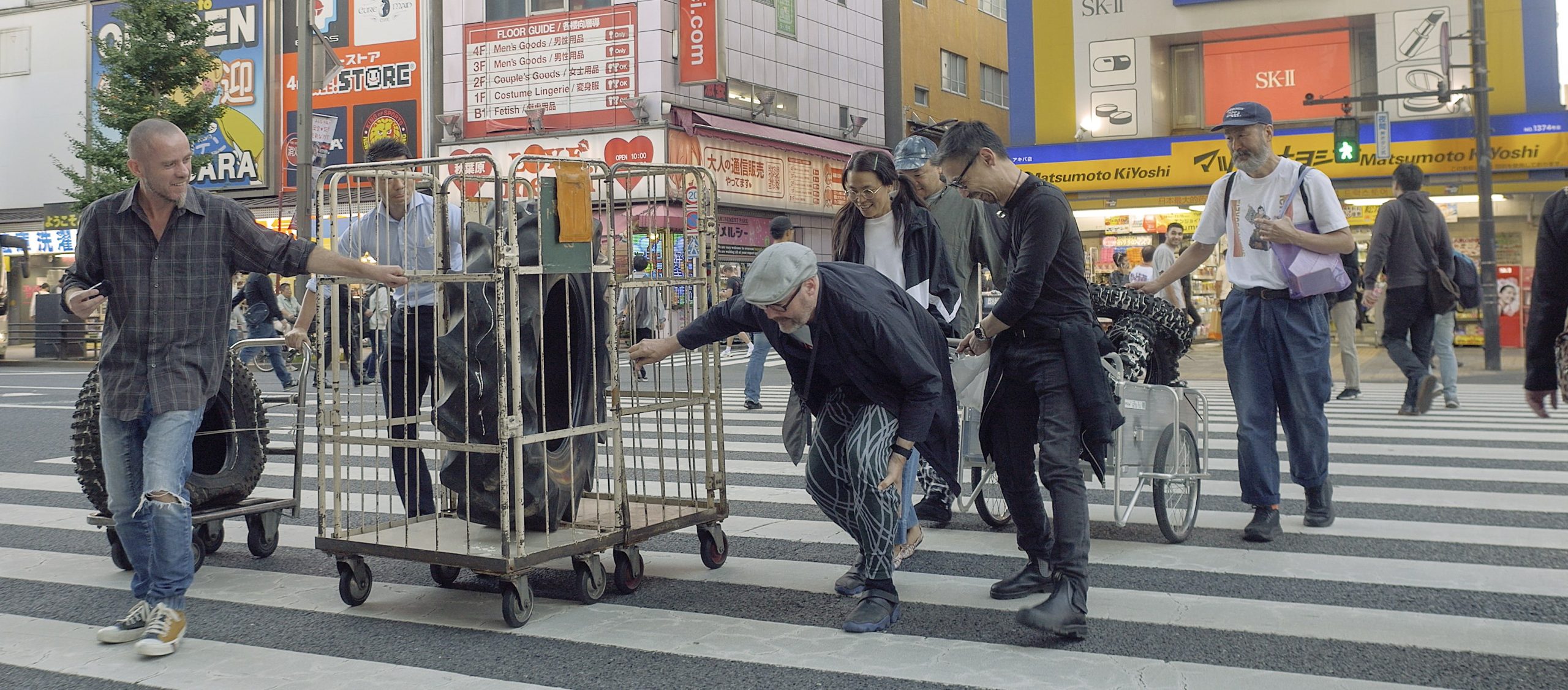
Street action, Oct.04. Image - Yugo Hattori
Performed by Michael and his team, the street actions aim to ‘relink’ the outer moat system by using old tires as conceptual apparatus for rewilding the city. The artist rolls river water inside the trough of the tire rims, to become wayfinders, fountains, and time portals, reconnecting existing waterscapes to ghost moats and lost canals.
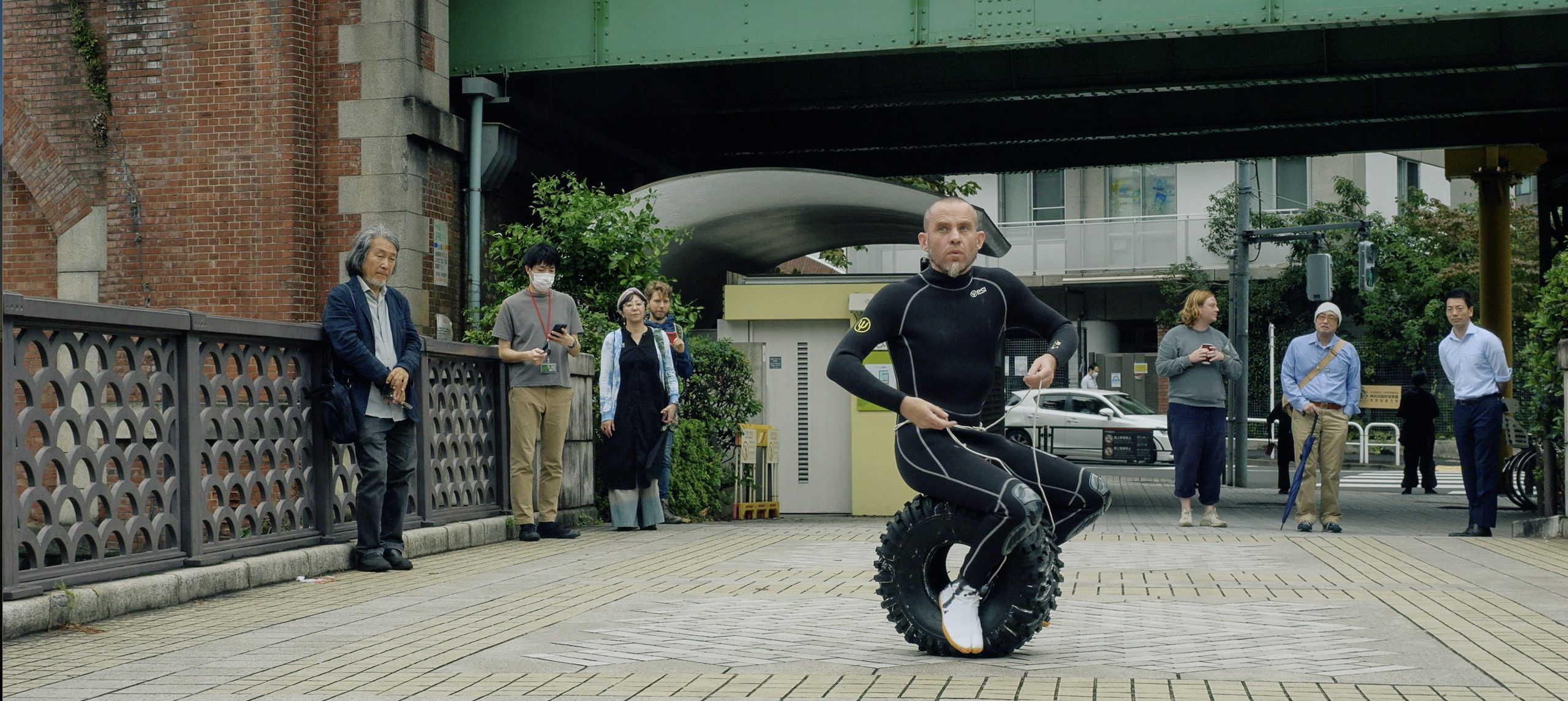
Street action, Oct.04. Image - Yugo Hattori
The Street Actions are performed in strategic locations around the Sotobori moat system, over the course of the 6-week residency. Together, the Street Actions, and the Sotobori Walks related to them, link the whole circuit of the outer moat. Members of the public are invited to join, watch, and discuss with the artist (in English with Japanese translation).
Date/Time: Oct.4 (Wed) 14:00–16:00
Venue: JAPAN ART BRIDGE, mAAch ecute Kanda Manseibashi
Admission: Free
*Additional Street Actions are unscheduled, to be observed mainly by those passing by at the time. If you would like to join, see the project website & Facebook pages for updates: https://www.michaelhornblow.com/whyistheriverlaughing
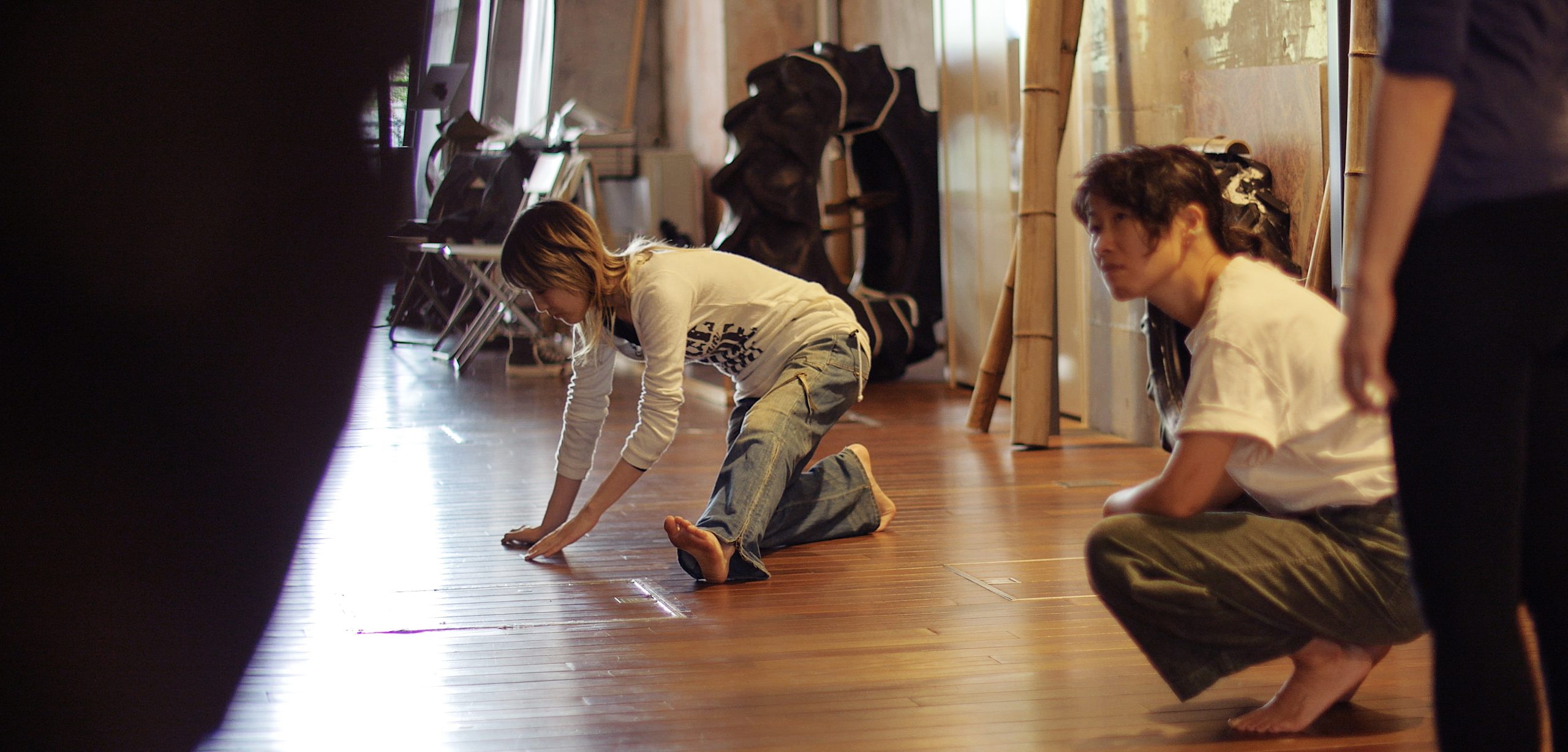
Dance Workshop, Oct.07. Image - Yugo Hattori
This dance workshop draws on Butoh, Bodyweather, Grotowski Method, and Performance Art, combining psychophysical and site-specific performance techniques. We will explore flow states, locating presence, the pressure of time, and the vitality of objects, with elements from the project exhibition offering concepts and materials for experimentation. Michael has 25+ years performance experience, including training with Kazuo Ohno, Min Tanaka, Ko Murobushi, Tony Yap, and others; and performing around the World, especially in Asia. The class is accessible to all levels of experience, with a background in dance/performance most welcome. Wear comfortable active wear.
Date/Time: Oct.7(Sat)11:00–14:00
Venue: JAPAN ART BRIDGE, mAAch ecute Kanda Manseibashi
Admission: 500JPY (please pay on site on the day)
*English <> Japanese interpretation is available
*There will be a short break at 12:30, but please have something light to eat before class, so you can have a late lunch at 2pm when we finish, without getting too hungry.
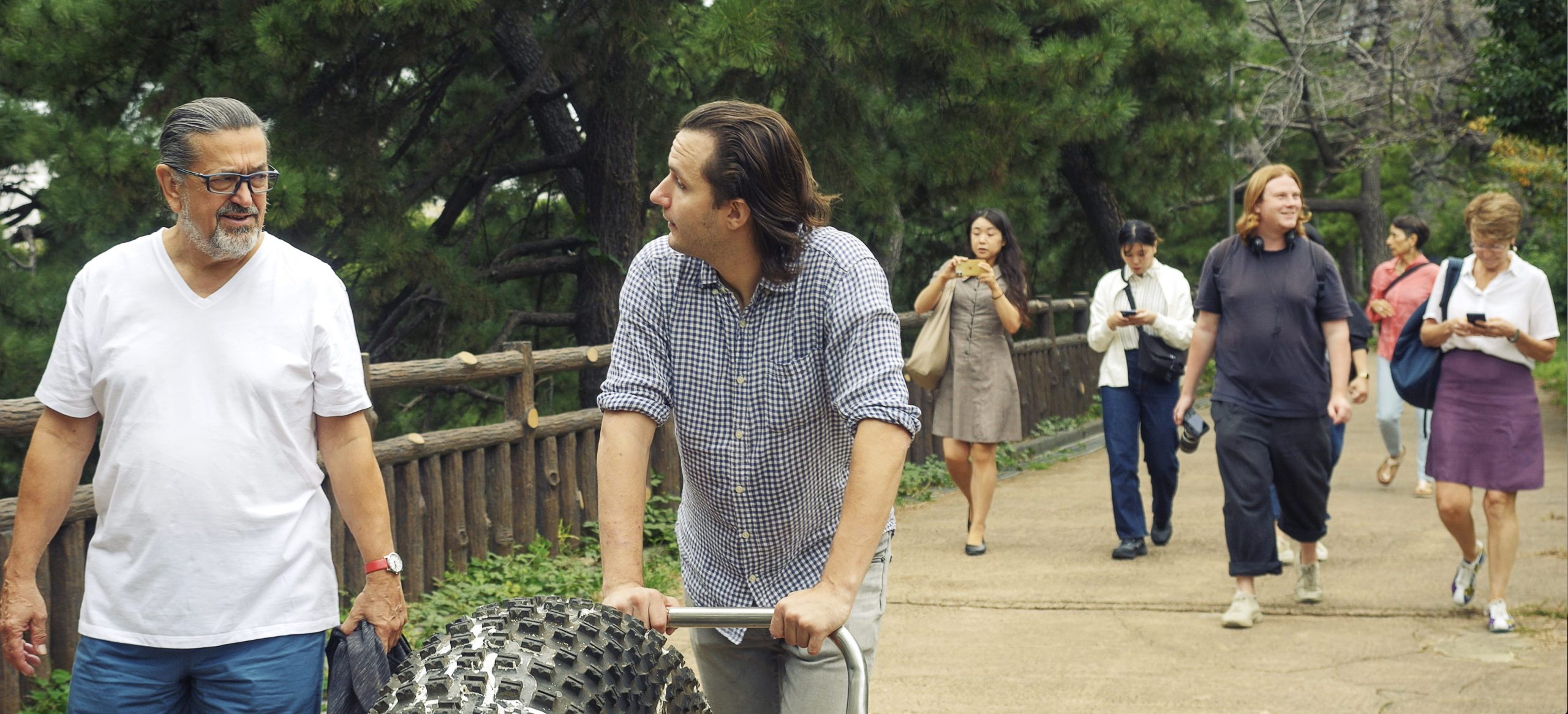
Sotobori Walk, Oct.08. Image - Michael Hornblow
The Sotobori Walks are a series of short walks around the old outer moat system of the Imperial Palace, including existing waterscapes and routes where canals have been lost over time. Together, the Sotobori Walks, and the Street Actions related to them, link the whole circuit of the outer moat. Anyone is welcome to join and chat with the artist and creative team as we walk along. More of a prospecting activity than a guided tour, we’d like to connect with people who have stories and local knowledge about these areas; and those who like to experience the activity of walking together, listening and observing, collectively tuning into the environment as we move through it.
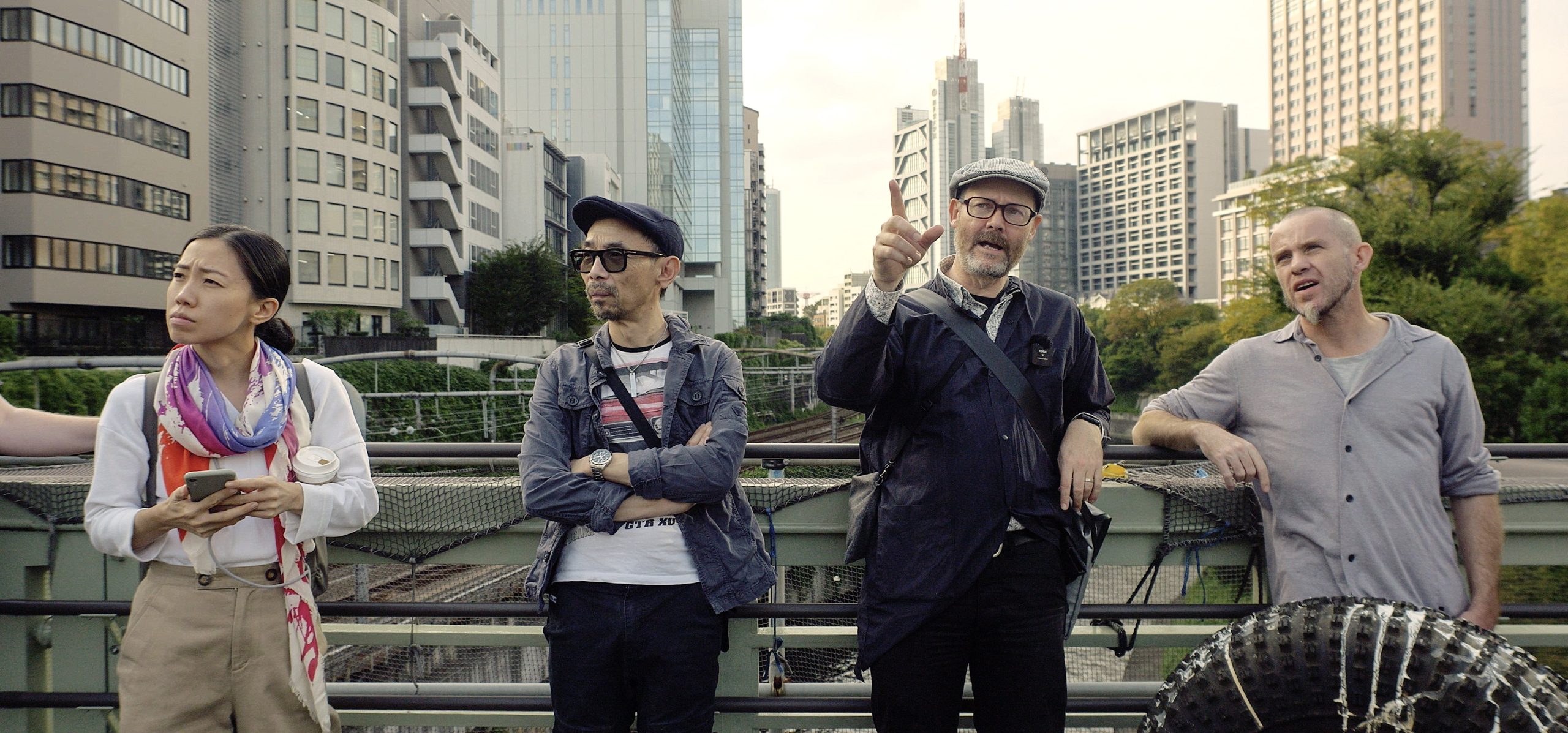
Sotobori Walk, Oct.14. Image - Michael Hornblow
Routes and Schedule
Date/Time: Oct.8 (Sun) 13:30–15:00 - Ichigaya > Benkaibashi > Toranomon
Meeting point for the Sotobori Walk... Meet at Ichigaya Mitsuke Police Box 4 Chome-4-1 Kudanshita, Chiyoda City, Tokyo 102-0073
*English <> Japanese interpretation is available
Oct.14 (Sat) 13:30–15:00- Manseibashi > Iidabashi > Ichigaya (part of Mapping Workshop)
*English <> Japanese interpretation is available
*Additional Sotobori Walks, dates TBA. If you would like to join, see the project website & Facebook pages for updates: https://www.michaelhornblow.com/whyistheriverlaughing
Toranomon > Nihonbashi
Nihonbashi > Koishikawa
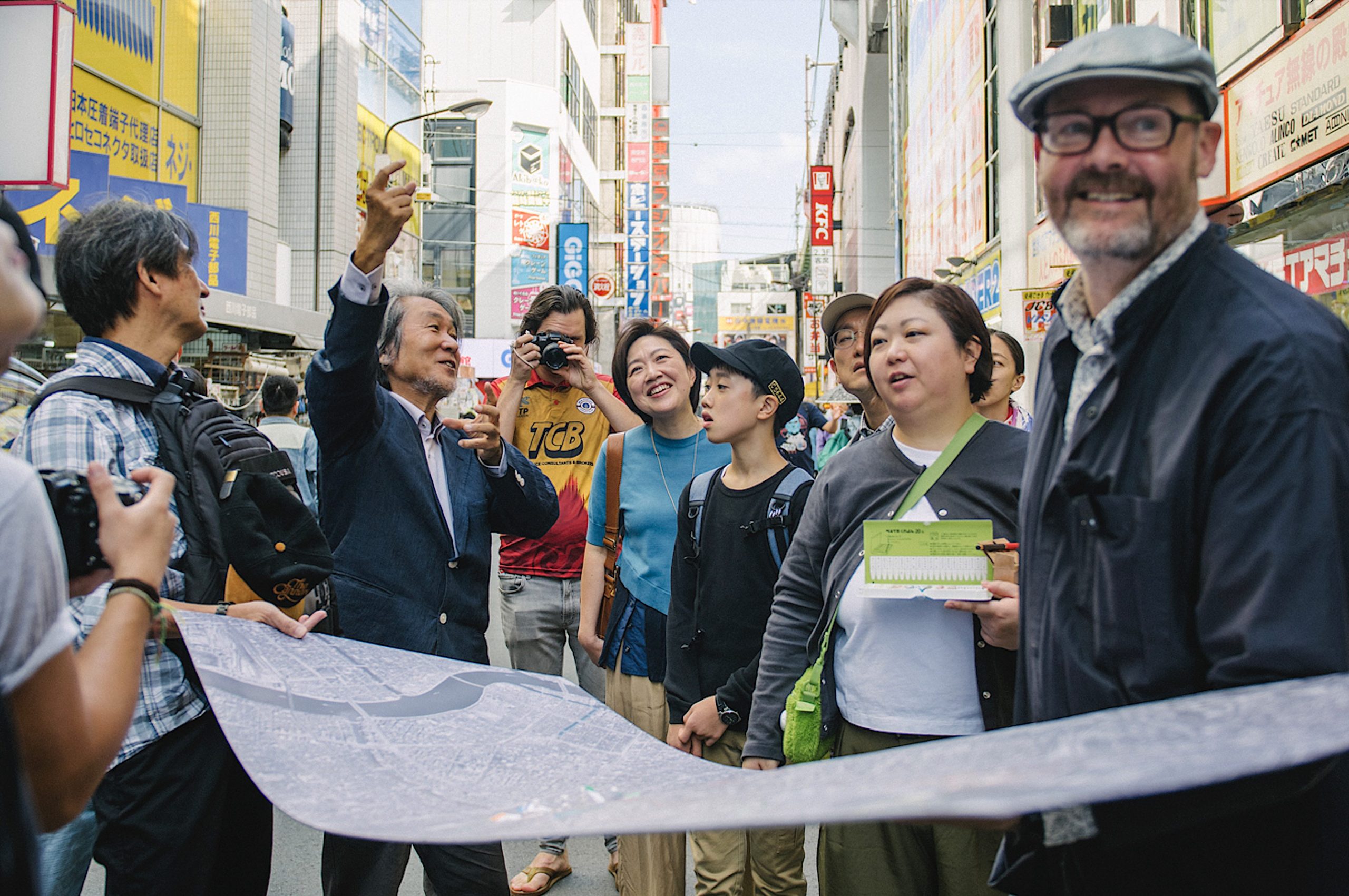
Mapping Workshop Oct.14. Image - Yuka Ikenoya(YUKAI)
This workshop in Experimental Cartography uses maps of Tokyo from modern times going way back to the Edo period. With analogue and digital reference points, we develop collaged studies drawn from multiple maps across different historical periods, combined to describe one terrain. Like time travelers, we gather stories, trace street actions, and invent new tributaries. At the end of the workshop, we will walk along the river from Japan Art Bridge in Manseibashi to Ichigaya, mapping our way as we go.
Date/Time: Oct.14(Sat)Workshop 11:00–13:30 Sotobori walk 13:30–15:00
Venue: JAPAN ART BRIDGE, mAAch ecute Kanda Manseibashi
Admission: 500JPY(please pay on site on the day)
Team members - Julian Worrall, Michael Hornblow, Pino Heye, Meherzad Shroff
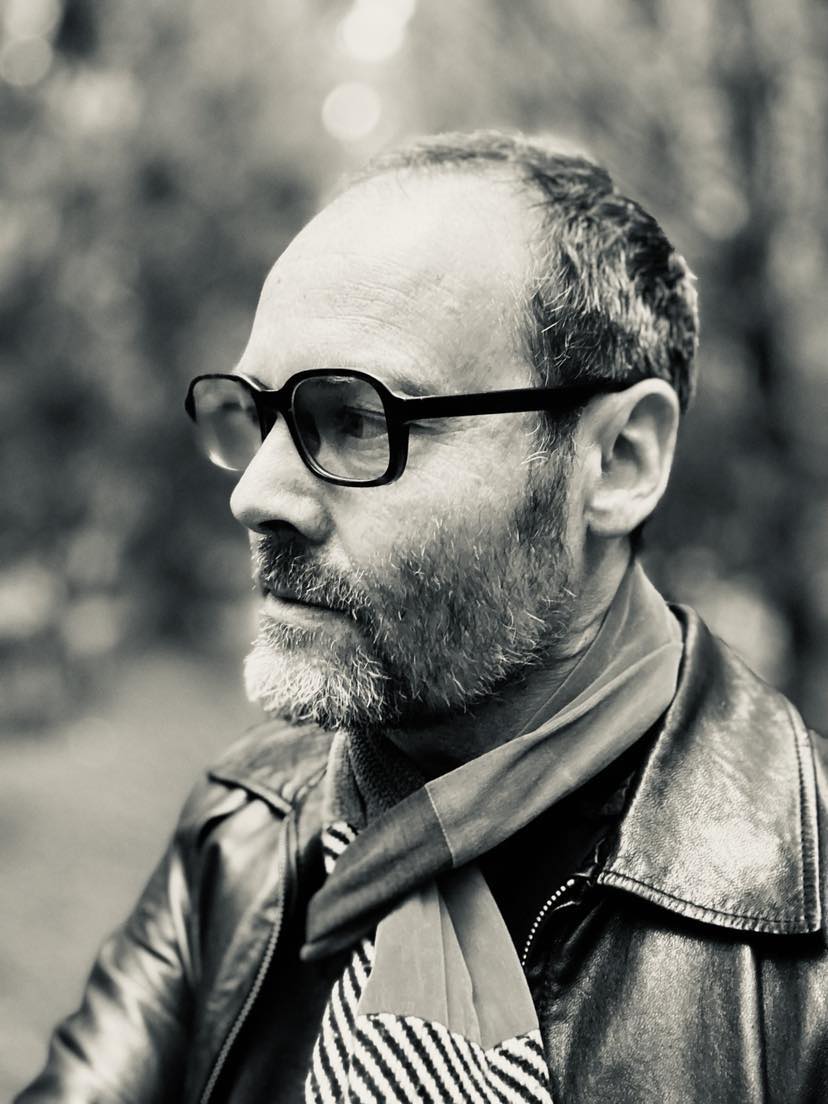
Julian Worrall is an Australian architect, scholar, critic and curator, and Professor of Architecture at the University of Tasmania. With a doctorate in urban history from the University of Tokyo (2005), his research engages themes of modernity, publicness, neutrality, displacement and temporality in architecture and cities, through scholarly studies encompassing spatial history, contemporary architecture, rural revitalisation, urban vernaculars, and critical heritage. These themes are also mobilised through creative and curatorial collaborations, including (with Aglaia Konrad) Japan Works (2021) and (with Ali Gumillya Baker, Anthony Coupe, Emily Paech, and Sarah Rhodes) Unsettling Queenstown (2023), the Australian representation at La Biennale di Venezia 2023. He lives in Launceston, Tasmania and maintains a base in Tokyo.

Michael is an Artist / Researcher from New Zealand with a multidisciplinary background across dance, performance art, architecture and design, video, public art, and community development. He completed his PhD in the Spatial Information Architecture Laboratory at the Royal Melbourne Institute of Technology (Australia), and was a Postdoctoral Fellow in the Senselab at Concordia University in Montreal (Canada). Michael’s art presentations include Melbourne Festival, the International Symposium on Electronic Art (Sydney, Vancouver, Hong Kong); and a long history of creative work in Asia - training with Butoh masters in Japan, performing at Melaka Festival in Malaysia, Asiatopia International Performance Art Festival, and Bangkok Design Week in Thailand, Pelem and Arts Island Festivals in Indonesia. Michael is based in Bangkok, where he teaches in the School of Global Studies at Thammasat University. He is Co-Founder and Artistic Director of Buffalo Field Festival in the old town area of Nang Loeng, focused on site-specific performance and community engagement.
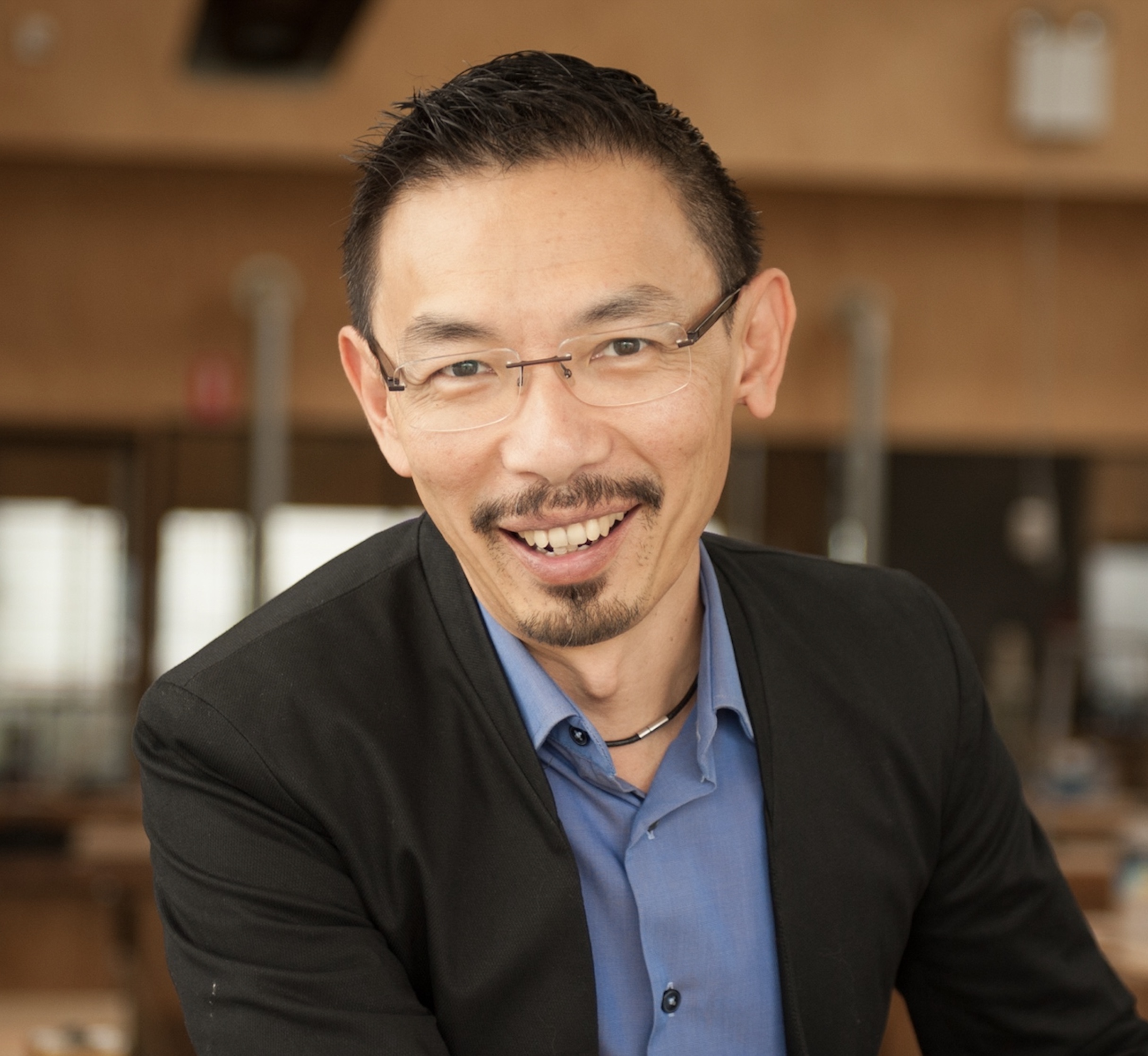
Stephen Loo is Professor of Design at the University of New South Wales in Melbourne, Australia. He researches, teaches and practices in the transdisciplinary nexus of art, architecture, design, philosophy, performance and science. He has published widely on biophilosophy, posthumanist ethics, ecological humanities and experimental digital thinking. Stephen is a founding partner of award-winning design, architecture, interpretation and exhibition practice Mulloway Studio. He has a performance-philosophy based art practice and has shown internationally in Paris, Berlin, London, Prague, Melbourne, Sydney and Adelaide.
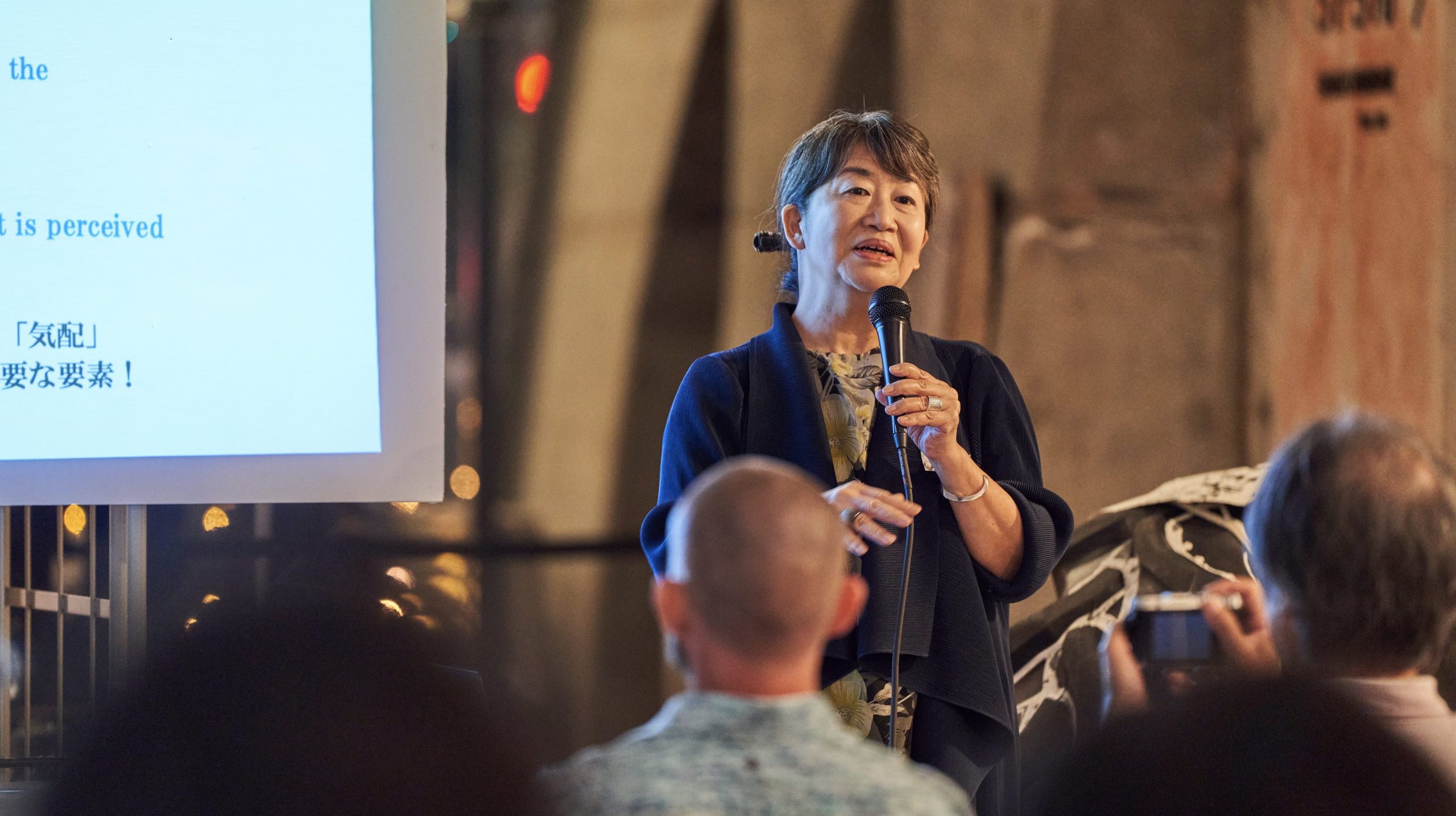
Prof Keiko Torigoe, Symposium speaker. Image - Akiko Hashiguchi
The symposium responds to the Tokyo Biennale theme of ‘linkage’ by relinking the river – to its ghost moats and lost canals, to history, topography, ecology, art and design. We explore how waterways connect with Tokyo people at a deeper level, residents and visitors alike, as we see a new appreciation for the city’s waterscapes appearing. The symposium features a keynote lecture with Hidenobu Jinnai, followed by short talks and conversation with Keiko Torigoe and Norihisa Minagawa, a creative forum with Michael Hornblow, Julian Worrall, and Stephen Loo, and a performance by Michael and Jean-David Caillouët.
Date/Time: Oct.15(Sun) 16:00–19:30
Venue: JAPAN ART BRIDGE, mAAch ecute Kanda Manseibashi
Admission: 500JPY (please pay on site on the day)
Capacity: 40 people
Consecutive interpretation provided
Inquiries E-mail: cy(at)tokyobiennale.jp
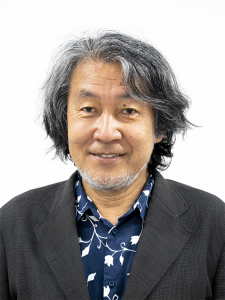
Born in 1947 in Fukuoka, Japan, Jinnai pursued studies at Università Iuav di Venezia and later earned a Ph.D. from the University of Tokyo's Graduate School of Engineering. Presently, he holds the position of a specially appointed professor at Hosei University. In addition to this role, Jinnai serves as the director of the Chuo Historical Museum/Planetarium and assumes the role of chair of the jury for both the Townscape Grand Prize and the Kawamachi Grand Prize, both administered by the Ministry of Land, Infrastructure, Transport, and Tourism. Jinnai's scholarly expertise is concentrated within the domains of Italian architectural history, urban history, and, more specifically, the urban history of the aqueous metropolis of Tokyo. Among his publications are "Venezia - Suijo no Meikyu Toshi (Venice - Labyrinth City on the Water)" (Kodansha), "Suitogaku (Water Metropolis Studies)" in five volumes (co-edited, Hosei University Press) and "Suito Tokyo - Chikei to Rekishi Kara Yomitoku Shitamachi・Yamanote・Kougai (Water Metropolis Tokyo - Topography and History to read and understand downtown, Yamanote and the suburbs" (Chikuma Shobo).

Exploring the theme of soundscapes, Torigoe engages in research, spanning 'environmental and cultural resources' across diverse regions in Japan. Her research, grounded in the principles of environmental conservation, informs her practice, encompassing urban planning, workshops, and community art initiatives. Her overarching goal is to harness the potential of soundscapes as a strategic conduit for reintegrating the modernity framework. Notable among her publications is "Saundosukēpu – Sono Shisō to Jissen (Soundscapes: Ideas and Practices)." Currently, she holds the position of Professor at the Department of Cultural and Creative Studies at Aoyama Gakuin University and serves as the Representative Director of the Japan Soundscape Association.

Born in 1963 in Gunma, Japan, Minaqua holds the position of chair at the Tokyo Suribachi Gakkai, serves as a first-class architect for Kajima Corporation, and also works as a part-time lecturer at Hosei University. In 2003, he founded the Tokyo Suribachi Gakkai and has since dedicated himself to the meticulous observation and documentation of Tokyo's distinctive and uneven topography through extensive fieldwork. His contributions in this field earned him the prestigious Good Design Award in 2014, followed by the Chiiki Saisei Award (Regional Regeneration Award) in 2023. Among his notable publications are “Tokyo Suribachi no Tatsujin (Tokyo Suribachi Master)” (Shobunsha) and “Outotsu wo Tanoshimu Tokyo Suribachi Chikei Sanpo (Enjoying the Unevenness of Tokyo Suribachi Topography Walk)” (Takarajima-sha).

Julian Worrall is an Australian architect, scholar, critic and curator, and Professor of Architecture at the University of Tasmania. With a doctorate in urban history from the University of Tokyo (2005), his research engages themes of modernity, publicness, neutrality, displacement and temporality in architecture and cities, through scholarly studies encompassing spatial history, contemporary architecture, rural revitalisation, urban vernaculars, and critical heritage. These themes are also mobilised through creative and curatorial collaborations, including (with Aglaia Konrad) Japan Works (2021) and (with Ali Gumillya Baker, Anthony Coupe, Emily Paech, and Sarah Rhodes) Unsettling Queenstown (2023), the Australian representation at La Biennale di Venezia 2023. He lives in Launceston, Tasmania and maintains a base in Tokyo.

Stephen Loo is Professor of Design at the University of New South Wales in Melbourne, Australia. He researches, teaches and practices in the transdisciplinary nexus of art, architecture, design, philosophy, performance and science. He has published widely on biophilosophy, posthumanist ethics, ecological humanities and experimental digital thinking. Stephen is a founding partner of award-winning design, architecture, interpretation and exhibition practice Mulloway Studio. He has a performance-philosophy based art practice and has shown internationally in Paris, Berlin, London, Prague, Melbourne, Sydney and Adelaide.
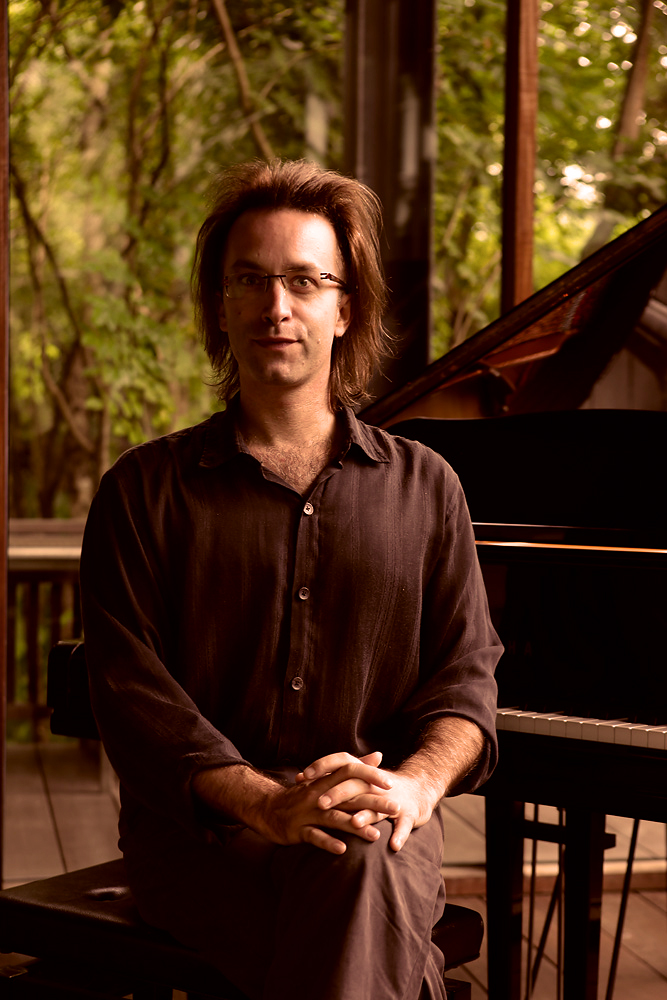
Jean-David Caillouët is a French sound and visual artist. Mixing the old with the new, his work often combines film, music (acoustic & electronic), choreography and poetry in a live performance context. He has performed internationally, playing well respected festivals such as Celtic Connections, Edinburgh Fringe, Big Mountain festival in Thailand, and KLEX in Malaysia. He has produced soundtracks for films, animations, theatre and dance. His work has been performed in the Royal Opera House and the Queen Elizabeth Hall in London and his installation projects have been presented in places as varied as the historical caves of Kent’s Cavern in the UK, Le Musée du Quai Branly in Paris, the Angkor Temples in Cambodia, and Bangkok’s Art and Culture Center.

Michael is an Artist / Researcher from New Zealand with a multidisciplinary background across dance, performance art, architecture and design, video, public art, and community development. He completed his PhD in the Spatial Information Architecture Laboratory at the Royal Melbourne Institute of Technology (Australia), and was a Postdoctoral Fellow in the Senselab at Concordia University in Montreal (Canada). Michael’s art presentations include Melbourne Festival, the International Symposium on Electronic Art (Sydney, Vancouver, Hong Kong); and a long history of creative work in Asia - training with Butoh masters in Japan, performing at Melaka Festival in Malaysia, Asiatopia International Performance Art Festival, and Bangkok Design Week in Thailand, Pelem and Arts Island Festivals in Indonesia. Michael is based in Bangkok, where he teaches in the School of Global Studies at Thammasat University. He is Co-Founder and Artistic Director of Buffalo Field Festival in the old town area of Nang Loeng, focused on site-specific performance and community engagement.
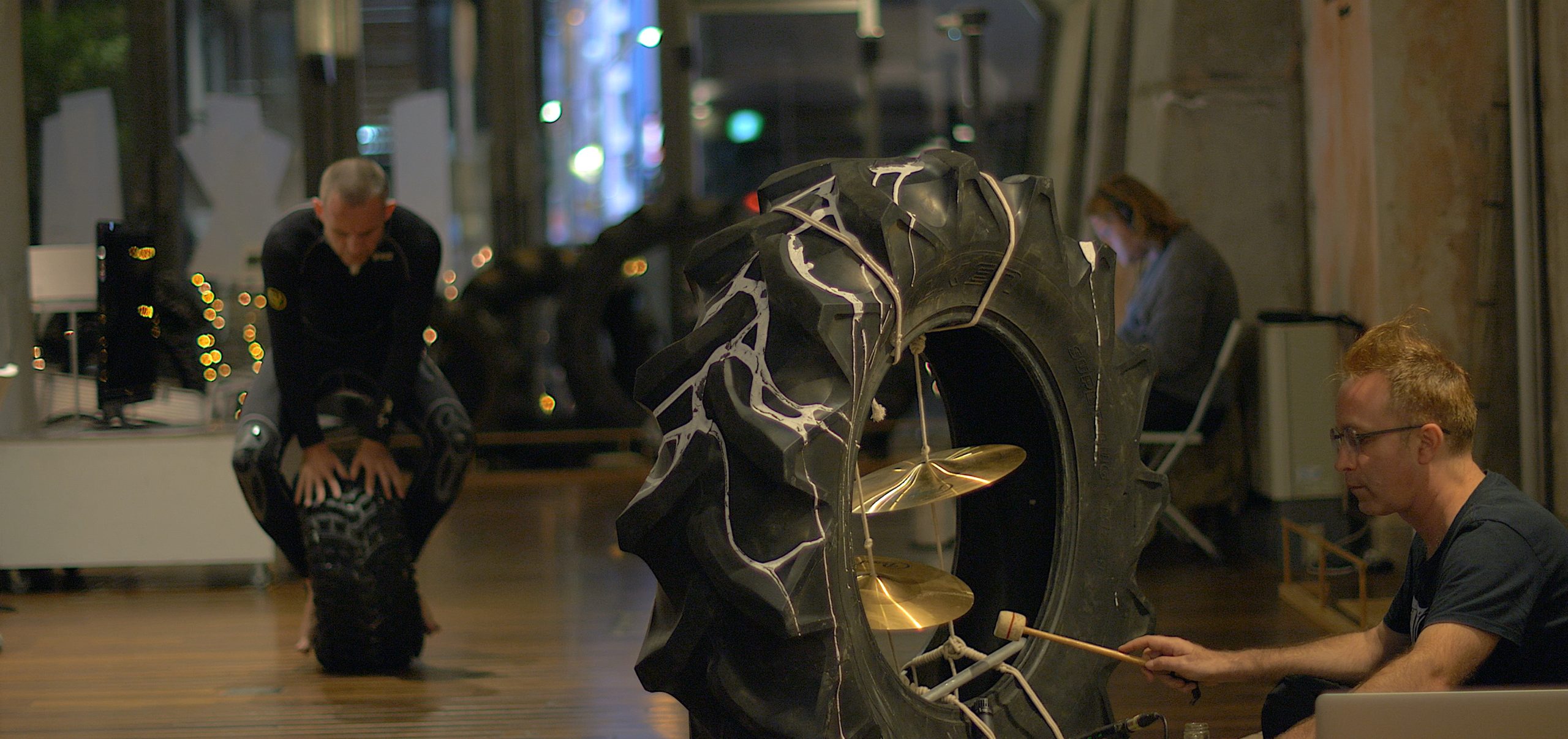
Performance, Oct.16-19. Image - Yugo Hattori
Coda | Comma
We continue working in the space at Japan Art Bridge in the days following the symposium, with a process of creative development that brings together the various stands of Why is the River Laughing? as a whole project. Improvisation across movement and sound informed by concepts from the Symposium, street actions, and workshops, experimenting with new linkages of transcultural knowledge and practice. Feel free to drop in at any point, to look, listen, and chat… or join us on the evenings of Oct.16 and Oct.19 for a special showing of work in progress.
Artists: Jean David Caillouët, Stephen Loo, Michael Hornblow
Date/Time: Open Studio, Oct.16-19 (Mon-Thu), 11:00-20:00 / Special Showing, Oct 16 (Mon) & Oct.19 (Thu), 18:30–19:30
Venue: JAPAN ART BRIDGE, mAAch ecute Kanda Manseibashi
Admission: Free
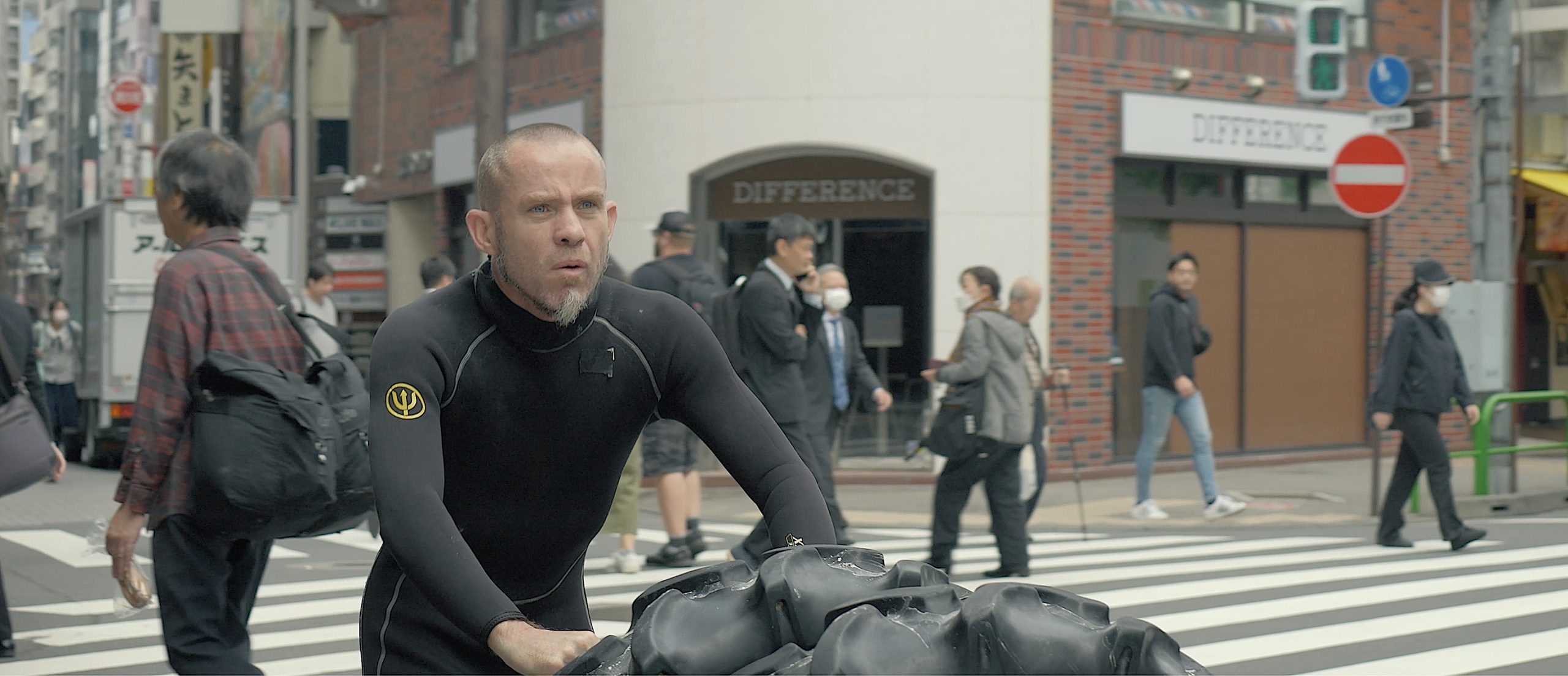
Michael Hornblow, performance lecture. Image - Yugo Hattori
In this performance lecture, live streamed from the Tokyo Biennale to Arizona State University, Michael Hornblow explores how local waterways reflect the changing course of cultural, political, and natural forces in Tokyo. Adopting a guise of ‘becoming-alien’, he transposes the converging crises of precarious global conditions – environment, technology, governance, subjectivity, via a confluence of media – performance, installation, video, cartography, writing. The tractor tire becomes a conceptual apparatus for inventing new tributaries, where alt. urban mythologies alternate in time, scale, and mode of inquiry.
Date/Time: Oct.26 (Thu), 08:30–09:15
| September 24, 14:00–17:00 | Performance |
| September 30, 18:30–19:30 | Performance + Sound art |
| October 04, 14:00–16:00 | Street Action |
| October 07, 11:00–14:00 | Dance Workshop |
| October 08, 13:30–15:00 | Sotobori Walk |
| October 13, 15:00–17:00 | Street Action |
| October 14, 11:00–15:00 | Mapping Workshop + Sotobori Walk |
| October 15, 16:00–19:30 | Symposium + Performance |
| October 16-19, 18:30-19:30 | Special Showing |
| October 26, 08:30–09:15 | Performance Lecture |
Artists・Members
Map
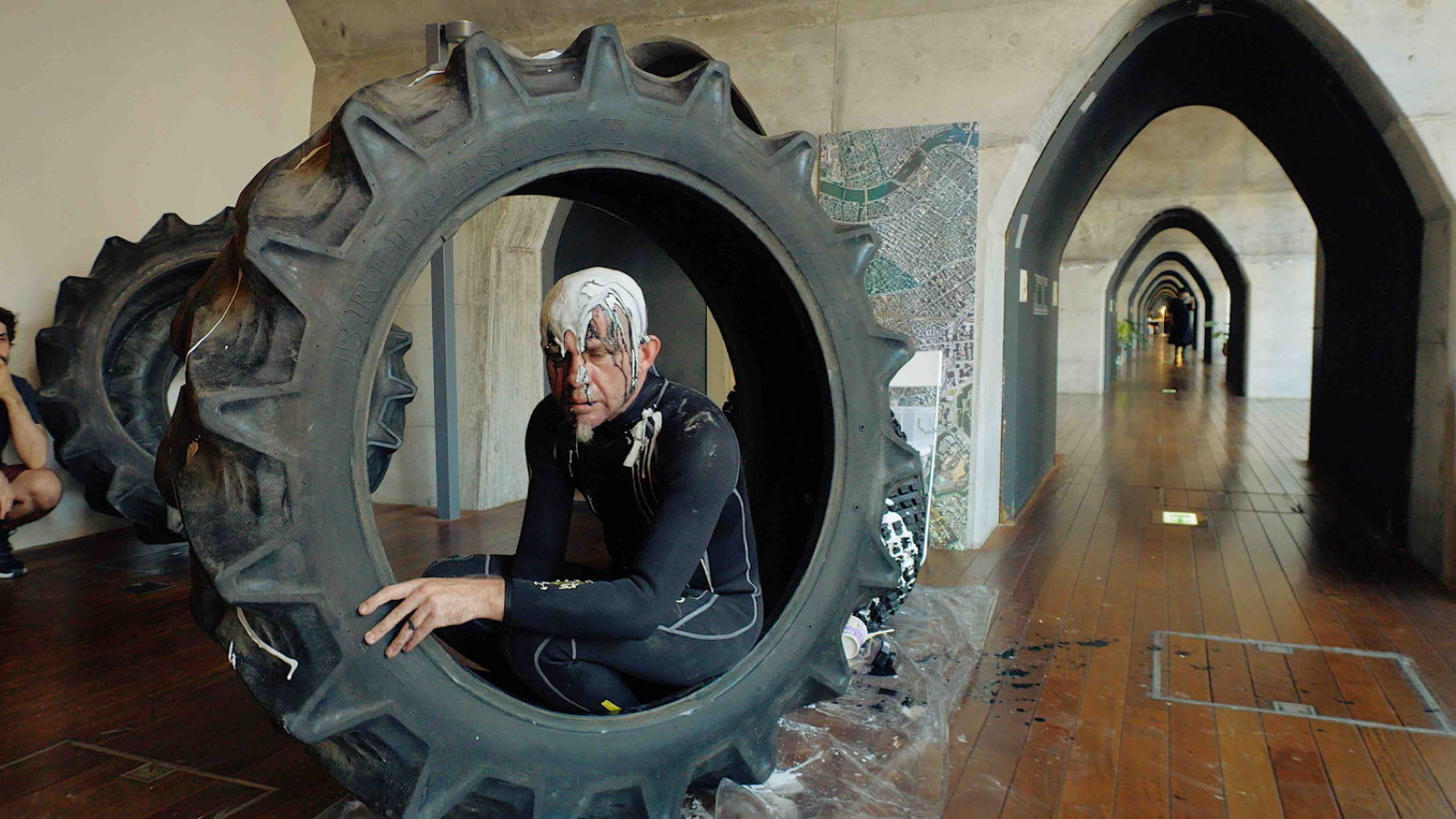
LINKAGE
[Social Dive Projects] Michael Hornblow: Why is the River Laughing?
Using old tires as a unique metaphor, an attempt to trace the structure of rivers and canals that have reflected political and natural changes in Tokyo and connect it to the future.
detailsEnded
Exhibition
Public production
Performance
Workshop
Other
K
Kanda・Yushima
JAPAN ART BRIDGE
mAAch ecute Kanda Manseibashi
25-4, Kandasudacho 1-chome, Chiyoda-ku, Tokyo
2023.9.23 - 11.5
11:00-18:00 Closed on 10.2
Ticket
Free